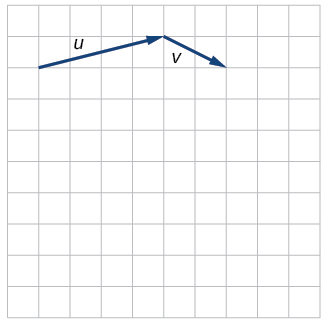10.8E: Vectores (Ejercicios)
- Page ID
- 112114
Para los siguientes ejercicios, determinar si los dos vectores,\(\mathbf{u}\) y\(\mathbf{v},\) son iguales, donde\(\mathbf{u}\) tiene un punto inicial\(P_{1}\) y un punto terminal\(P_{2},\) y\(\mathbf{v}\) tiene un punto inicial\(P_{3}\) y un punto terminal\(P_{4}\).
52. \(P_{1}=(-1,4), P_{2}=(3,1), P_{3}=(5,5)\)y\(P_{4}=(9,2)\)
53. \(P_{1}=(6,11), P_{2}=(-2,8), P_{3}=(0,-1)\)y\(P_{4}=(-8,2)\)
Para los siguientes ejercicios, use los vectores\(\mathbf{u}=2 \mathbf{i}-\mathbf{j}, \mathbf{v}=4 \mathbf{i}-3 \mathbf{j},\) y\(w=-2 \mathbf{i}+5 \mathbf{j}\) evalúe la expresión.
54. \(u-v\)
55. \(2 v-u+w\)
Para los siguientes ejercicios, encuentre un vector unitario en la misma dirección que el vector dado.
56. \(a=8 i-6 j\)
57. \(b=-3 i-j\)
Para los siguientes ejercicios, encuentra la magnitud y dirección del vector.
58. \(\langle 6,-2\rangle\)
59. \(\langle-3,-3\rangle\)
Para los siguientes ejercicios, calcule\(\mathbf{u} \cdot \mathbf{v}\).
60. \(u=-2 i+j\)y\(v=3 i+7 j\)
61. \(u=i+4 j\)y\(v=4 i+3 j\)
62. Dado\(\boldsymbol{v}=\langle-3,4\rangle\) sorteo\(\boldsymbol{v}, 2 \boldsymbol{v},\) y\(\frac{1}{2} \boldsymbol{v}\)
63. Dados los vectores mostrados en la Figura 4, boceto\(\boldsymbol{u}+\boldsymbol{v}, \boldsymbol{u}-\boldsymbol{v}\) y\(3 \boldsymbol{v}\).

Figura 4
64. Dado punto inicial\(P_{1}=(3,2)\) y punto terminal\(P_{2}=(-5,-1),\) escribir el vector\(\mathbf{v}\) en términos de\(\mathbf{i}\) y\(\mathbf{j}\). Dibuja los puntos y el vector en la gráfica.


